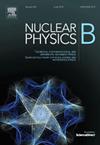Bipartite expansion beyond biparticity
IF 2.5
3区 物理与天体物理
Q2 PHYSICS, PARTICLES & FIELDS
引用次数: 0
Abstract
The recently suggested bipartite analysis extends the Kauffman planar decomposition to arbitrary N, i.e. extends it from the Jones polynomial to the HOMFLY polynomial. This provides a generic and straightforward non-perturbative calculus in an arbitrary Chern–Simons theory. Technically, this approach is restricted to knots and links which possess bipartite realizations, i.e. can be entirely glued from antiparallel lock (two-vertex) tangles rather than single-vertex -matrices. However, we demonstrate that the resulting positive decomposition (PD), i.e. the representation of the fundamental HOMFLY polynomials as positive integer polynomials of the three parameters ϕ, and D, exists for arbitrary knots, not only bipartite ones. This poses new questions about the true significance of bipartite expansion, which appears to make sense far beyond its original scope, and its generalizations to higher representations. We have provided two explanations for the existence of the PD for non-bipartite knots. An interesting option is to resolve a particular bipartite vertex in a not-fully-bipartite diagram and reduce the HOMFLY polynomial to a linear combination of those for smaller diagrams. If the resulting diagrams correspond to bipartite links, this option provides a PD even to an initially non-bipartite knot. Another possibility for a non-bipartite knot is to have a bipartite clone with the same HOMFLY polynomial providing this PD. We also suggest a promising criterium for the existence of a bipartite realization behind a given PD, which is based on the study of the precursor Jones polynomials.
超越双可性的二部展开
最近提出的二部分析将Kauffman平面分解扩展到任意N,即从Jones多项式扩展到HOMFLY多项式。这在任意的chen - simons理论中提供了一种通用的、直接的非微扰演算。从技术上讲,这种方法仅限于具有二部实现的结和链接,即可以完全由反平行锁(两个顶点)缠结粘合而不是单顶点r -矩阵。然而,我们证明了所得到的正分解(PD),即基本HOMFLY多项式作为三个参数φ, φ¯和D的正整数多项式的表示,存在于任意结,而不仅仅是二部结。这提出了关于二部展开的真正意义的新问题,它似乎远远超出了其原始范围,并将其推广到更高的表示。我们对非二部结的PD的存在提供了两种解释。一个有趣的选择是在非完全二部图中解析一个特定的二部顶点,并将HOMFLY多项式简化为较小图的线性组合。如果生成的图对应于二部链接,则此选项甚至可以提供初始非二部结的PD。非二部结的另一种可能性是具有相同HOMFLY多项式的二部克隆提供该PD。我们还基于前驱琼斯多项式的研究,提出了给定PD背后存在二部实现的一个有希望的准则。
本文章由计算机程序翻译,如有差异,请以英文原文为准。
求助全文
约1分钟内获得全文
求助全文
来源期刊

Nuclear Physics B
物理-物理:粒子与场物理
CiteScore
5.50
自引率
7.10%
发文量
302
审稿时长
1 months
期刊介绍:
Nuclear Physics B focuses on the domain of high energy physics, quantum field theory, statistical systems, and mathematical physics, and includes four main sections: high energy physics - phenomenology, high energy physics - theory, high energy physics - experiment, and quantum field theory, statistical systems, and mathematical physics. The emphasis is on original research papers (Frontiers Articles or Full Length Articles), but Review Articles are also welcome.
 求助内容:
求助内容: 应助结果提醒方式:
应助结果提醒方式:


